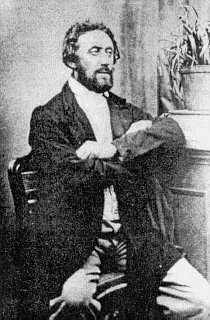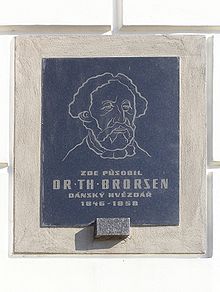Theodor Brorsen
Theodor Johann Christian Ambders Brorsen ( born July 29, 1819 in Nordborg, † March 31, 1895 ) was a Danish astronomer.
Life
Theodor Brorsen was born in Nordborg on Als (Northern Schleswig ), the son of Captain Christian August Brorsen ( 1793-1840 ) and his wife Annette Margrethe Gerhardine Schumacher ( 1788-1855 ). He got his three middle names after the maternal grandfather of his mother, the North Borger Justice Johann Christian Ambders ( 1710-1795 ). Since his parents' divorce in 1822 Brorsen grew up with his mother. Their good financial situation would allow him to after first lessons by a private tutor, the school of the Brethren in Christian field (1826-1829) and then to attend the Latin school in Flensburg until 1839. At the request of his mother Brorsen first began studying law in Kiel (1839 ), Berlin ( 1840), Heidelberg (1841 ) and again Kiel ( 1842), was, however, then his inclinations and studied from 1844 Astronomy in Kiel.
1846 worked at the astronomical observatory in Kiel Brorsen, 1847 in Altona. The offer of a place at the observatory " Rundetårn " ( Round Tower ) in Copenhagen, he refused. Instead, he took a job at the private observatory of Baron John Parish in Senftenberg in Bohemia. 1854 Brorsen applied without success to the vacant post of director of the observatory in Altona. After the death of Baron Parish in 1858, his heirs could demolish the observatory in Senftenberg and sell the instruments, although Brorsen had offered to continue to work for free. Nevertheless, remained Brorsen another twelve years in Senftenberg and continued the observations with his own instruments continued, but made no major discoveries more.
In 1870, he returned to his hometown of Nordborg in North Schleswig, which was Prussian since the War of 1864 German -Danish and then since 1871 ( until the vote in 1920 ) belonged to the German Empire, which Brorsen disapproved. In Nordborg he moved into in 1874, the still surviving house Løjtertoft 11, where he lived until his death. His half-sisters Amalie Petrine Brorsen (1832-1911) and Marie Jensen led him to the household. In his Nordborg years Brorsen dealt but hardly with astronomy, but especially with meteorology (including auroral observations) as well as botany, particularly with orchids.
Personally, Brorsen was an introverted character with bond fears. Twice he broke an engagement at the last minute again ( only with Louise let out Sonderburg, then with Miss Bern head from Senftenberg ) and therefore remained unmarried. Good evidence also that in Nordborg he put in his last 25 years idiosyncratic behaviors of the day: He was little on his clothes night, let his hair grow long, and when pressed him his boots, he cut at the appropriate places in holes. Every day he bathed in Oldenor, a lake at Nordborg; in winter he chopped This will be a hole in the ice. Brorsen died at age 75, and was buried on 5 April 1895 the North Borger Cemetery, where his grave still exists today. Since 1950 there is talk of the town Nordborg.
Discoveries
Brorsen discovered five comets: 1846 III, VII 1846, 1847 V, 1851 and 1851 III IV Two of them are named as a periodic comet after him: The comet 1846 III called Brorsen and the comet Brorsen - Metcalf 1847 V is called ( Metcalf after his rediscoverer 1919). The former 5D/Brorsen comet ( orbital period 5.46 years ) has not been sighted after five rounds observed since 1879; belonging to the group consisting of often short-lived Comets Jupiter comet family, it no longer exists today probably. The second, named after Brorsen 's Comet 23P/Brorsen-Metcalf ( orbital period 70.54 years, watching rounds in 1847, 1919 and 1989) belongs to the Halley comet family and is expected again for 2059. With the discovery of another comet (1850 II) came Brorsen an American astronomer, William Cranch Bond in Cambridge (Massachusetts), six days zurvor. Maybe Brorsen also discovered on March 16, 1854 a seventh comet; However, this finding could not be confirmed by other astronomers.
1850 discovered the Brorsen now known as "Flame Nebula " gas mist at Zeta Orionis, NGC 2024, and again, however previously - had already been discovered by William Herschel in 1786 and described - without Brorsens knowledge. 1856 discovered Brorsen the globular clusters in the constellation of the Serpent, which was cataloged as NGC 6539.
1854 published Brorsen the first systematic studies on the so-called counter- glow of the zodiacal light, in which he also explained the phenomenon already correct. This Brorsen also described as the first, that the zodiacal light covers the entire sky, because the zodiacal light and Gegenschein are connected by an under favorable conditions faint light bridge. Next examined Brorsen occultations and the proper motion of the fixed stars. When calculating astronomer he dealt particularly with the Perihelen of comets and planetary orbits.
Honors
For his first three comet discoveries Brorsen received by the Danish King Christian VIII each a golden comet medal; 1846 awarded him is now on display in the National Museum in Sønderborg Castle. Brorsen was appointed in 1850 a corresponding member of the Natural History Society in Senftenberg.
In his hometown of Nordborg today is named after a street Brorsen ( Th Brorsens vej ). Asteroid 3979, discovered on November 8, 1983 by Antonín Mrkos in Kleť was, on a proposal by Jana Ticha " Brorsen " called (MPC 27734-1996 August 28 ).










